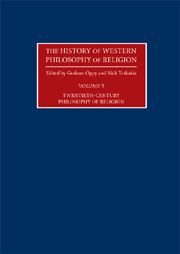Book contents
- Frontmatter
- Contents
- Editorial Introduction
- Contributors
- 1 Twentieth-Century Philosophy of Religion: An Introduction
- 2 William James
- 3 Henri Bergson
- 4 John Dewey
- 5 Alfred North Whitehead and Charles Hartshorne
- 6 Bertrand Russell
- 7 Max Scheler
- 8 Martin Buber
- 9 Jacques Maritain
- 10 Karl Jaspers
- 11 Paul Tillich
- 12 Karl Barth
- 13 Ludwig Wittgenstein
- 14 Martin Heidegger
- 15 Emmanuel Levinas
- 16 Simone Weil
- 17 A. J. Ayer
- 18 William P. Alston
- 19 John Hick
- 20 Mary Daly
- 21 Jacques Derrida
- 22 Alvin Plantinga
- 23 Richard Swinburne
- 24 Late-Twentieth-Century Atheism
- Chronology
- Bibliography
- Index
1 - Twentieth-Century Philosophy of Religion: An Introduction
- Frontmatter
- Contents
- Editorial Introduction
- Contributors
- 1 Twentieth-Century Philosophy of Religion: An Introduction
- 2 William James
- 3 Henri Bergson
- 4 John Dewey
- 5 Alfred North Whitehead and Charles Hartshorne
- 6 Bertrand Russell
- 7 Max Scheler
- 8 Martin Buber
- 9 Jacques Maritain
- 10 Karl Jaspers
- 11 Paul Tillich
- 12 Karl Barth
- 13 Ludwig Wittgenstein
- 14 Martin Heidegger
- 15 Emmanuel Levinas
- 16 Simone Weil
- 17 A. J. Ayer
- 18 William P. Alston
- 19 John Hick
- 20 Mary Daly
- 21 Jacques Derrida
- 22 Alvin Plantinga
- 23 Richard Swinburne
- 24 Late-Twentieth-Century Atheism
- Chronology
- Bibliography
- Index
Summary
Offering an overview of twentieth-century philosophy of religion is as daunting as offering a unified narrative of twentieth-century art. There is simply too much turbulence and diversity to make for any neat portrait. But one general observation seems secure: philosophical reflection on religion has formed a major, vibrant part of some of the best philosophy in the past century. We now have a virtual library of a hundred years of first-rate, diverse philosophy of religion. At the close of the century there are more societies, institutions, journals, conferences and publishing houses dedicated to philosophy of religion than any other area of philosophical enquiry. The enduring appeal of philosophy of religion may be seen in the fact that many prestigious twentieth-century philosophers whose names are not featured with their own chapter in this volume nonetheless did some work on the philosophy of religion. Selecting figures from the second-half of the twentieth century, Michael Dummett, Robert Nozick, Hilary Putnam and John Rawls are representative of those whose main work is remote from mainstream philosophy of religion, but who nonetheless contributed in different ways to philosophical reflection on God, revelation, the theistic problem of evil, mystical experience and the rationality of religious belief.
There are three sections in what follows. The first takes up what I suggest is the largest theme in twentieth-century philosophy of religion, the second takes up a greater breadth of projects and the third comments on one lesson we might learn from the historical study in this volume.
- Type
- Chapter
- Information
- The History of Western Philosophy of Religion , pp. 1 - 12Publisher: Acumen PublishingPrint publication year: 2009

